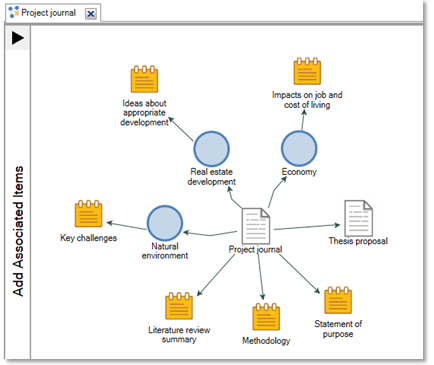Move forward with queries and visualizations
This topic describes some of the ways queries and visualizations can support you at each stage of the research process.
For more detailed information about the different types of queries and how to run them, refer to About Queries.
Some of the features described here are only available in NVivo Pro and NVivo Plus.
In this topic
- Get started with queries and visualizations
- Query and visualize during your literature review
- Query and visualize during research design and data collection
- Query and visualize during data analysis (coding)
- Using queries and visualizations during the final write-up
Get started with queries and visualizations
Queries and visualizations support the iterative nature of qualitative research and help you to investigate hunches as you progress through your project.
It is a good idea to start running queries early on—they can help you focus on the questions you want to ask (and prompt you to code accordingly). They can also help you to determine whether you need to gather additional sources of data or re-frame the questions you are asking.
To start with, you may want to run some simple queries and preview the results—refer to About queries to get up and running. As you grow in confidence, you can look at building more complex criteria and storing your results in nodes.
When you begin using queries it can help to remember:
-
Coding queries rely on the work you have done— patchy or inconsistent coding may yield less useful results.
-
Absence may be just as important as presence—search for where sources are NOT coded at a particular node and ask why.
-
Review the query results and make a memo to describe how it contributes to your understanding.
-
While queries and visualizations can give you different perspectives on your data, you will still need to use your analytical skills to interpret the results.
-
Saved queries can act as 'signposts' for future investigation, set them up early and rerun them as you progress through your project.
Query and visualize during your literature review
You can use NVivo for your literature review—and as your project progresses, you may return to the literature to see where your findings support or contradict those of other authors. As you conduct your literature review, you might use the following queries to explore the material:
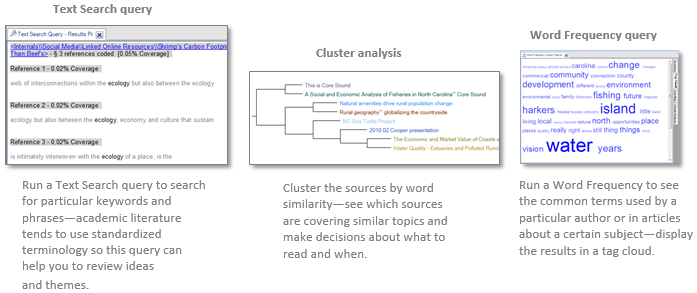
Once you have coded the literature, you could use other queries and visualizations to get an overview of the emerging themes—for example, you could create a Group query (and generate a connection map from the results).
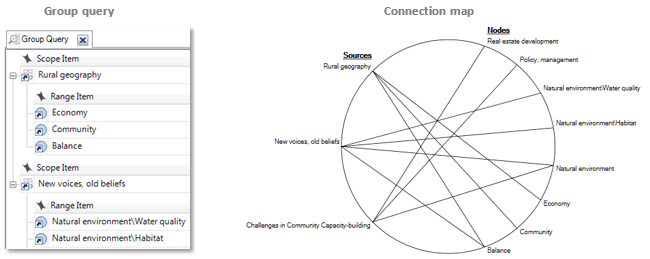
You may want to run a Matrix Coding query to see the coding at selected themes:
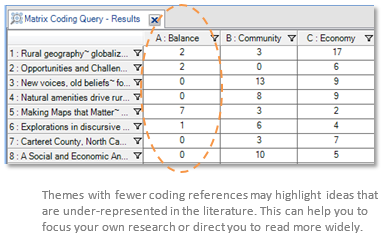
If you have classified the literature and assigned attributes (like author and publication date), you can use queries to do more targeted analysis—for example, you could create a chart to check the spread of your literature sources—is a particular author or institution over-represented, should you review a wider range of literature sources?
Query and visualize during research design and data collection
In order to keep reliable records and enhance transparency, you can import your research design materials into NVivo—for example, you might import your thesis proposal, project-related timetables, or literature related to methodology.
During research design and data collection, you could create maps to:
-
Show how you arrived at your approach to data collection and analysis
-
Set out and review initial ideas, hunches or theories related to your research question
-
Outline your project schedule, including dates and required tasks:

If you have imported literature related to research methods, you could run a Text Search query to find content based on keywords or use a Matrix Coding query to explore how different authors or researchers have applied a specific methodology:

As you move into the data collection phase of conducting interviews, surveys or focus groups you may want to collect demographic information about your respondents—for example, age, gender or location. You can import this 'classification' information or create it in NVivo—refer to Classify cases for information about how to do this. After classifying and setting up the attributes for your respondents, you can use queries or visualizations to explore your data. For example, you could:
-
Create a chart to check the spread of your respondents—is a particular demographic under-represented? Do you need to collect data from a wider range of respondents?
-
Import administrative items related to your respondents—like consent forms or email conversations. You can code these items at the case node for a respondent, and use a Group query to quickly list all the material related to a particular respondent.
Query and visualize during data analysis (coding)
Early on in your project, Text Search and Word Frequency queries can help you to organize your data into broad categories. For example, you could use a Text Search query to search for real estate development and automatically code all of the occurrences.
As you move into more detailed coding and continue to organize or 'segment' your data by theme—queries and visualizations can help you to reassemble and examine the themes in ways that address your research question. For example, you may want to explore the co-occurrence of themes (show me content coded at development AND water quality).
Rather than being a one-step process, querying your coding is iterative—one query or visualization may lead to another as you dig deeper into your data.
For example, to explore the idea that respondents are pessimistic about real estate development, you might run the following queries:
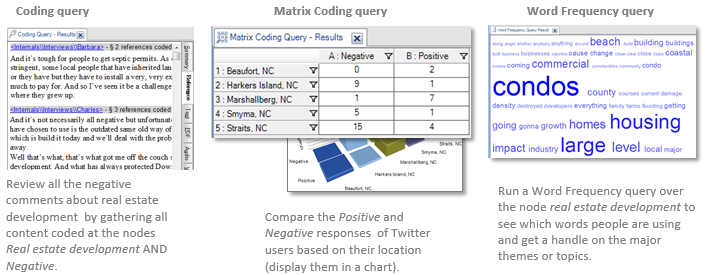
If you want to focus on the attitudes and experiences of a particular respondent—you might use the following queries and visualizations:
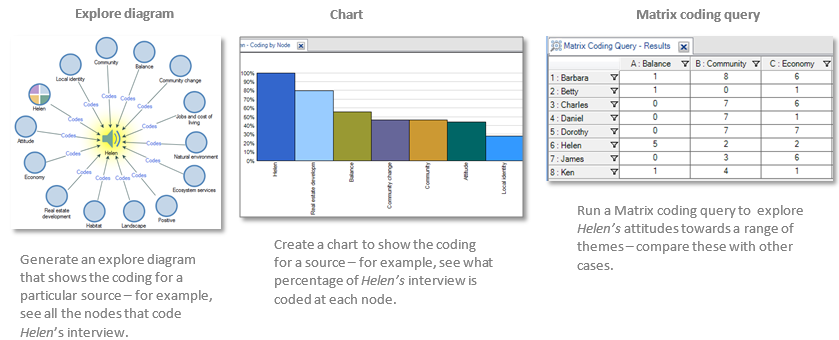
If you have used NCapture to collect social media data—for example, from Facebook or Twitter—you can geovisualize the data to see where social media commentators are located.
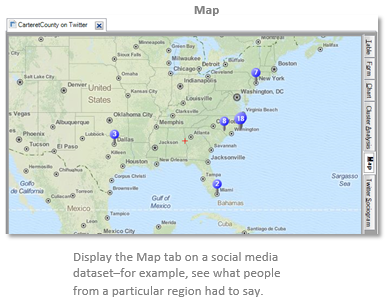
Using queries and visualizations during the final write-up
Rather than leaving it to the end, you can approach 'writing-up' as a continuous task that starts from the very beginning of a project. As you run queries and visualizations, you can create memos to document your findings—remember to include related visualizations and links to matrices. If you also code these memos, you can use a Coding query to quickly pull together all your ideas about a topic or a combination of topics.
During the final writing-up phase, you can also:
-
Export your query results—for example, to demonstrate the frequency or coverage of selected themes, you could export the results of a Matrix coding query to Microsoft Excel and use it in your final write-up.
-
Copy visualizations (like charts, maps and diagrams) and paste them into your report or presentation. You can also export a visualization as an image file or copy and paste it as a picture source in NVivo.
-
If you have a project journal that describes your path through the project, you can use it to create a project map. Keep this nearby as you write—double-click on a project item to easily access related information.
